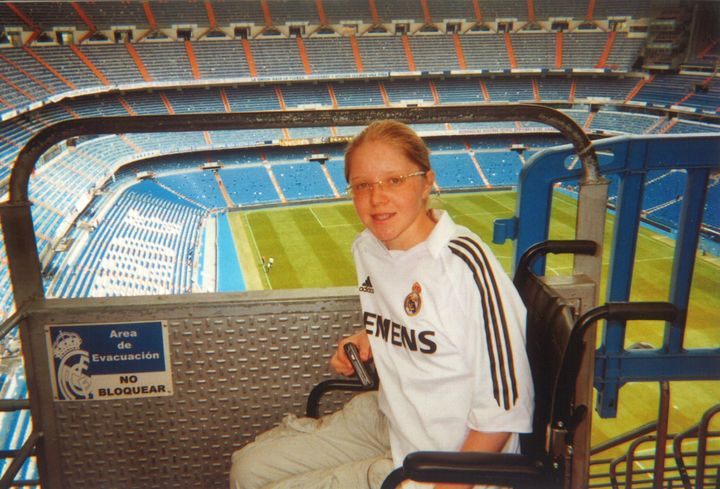Olivia McDonald missed two years of school when she first began experiencing symptoms of Myalgic Encephalopathy (ME) at the age of 12.
The condition, also known as Chronic Fatigue Syndrome (CFS), left her too exhausted to lift a spoon to eat breakfast, walk to the bathroom for a shower or chat with friends.
Olivia was forced to wait months and see multiple doctors before she could receive a diagnosis and access the treatment she needed, but support could be about to improve for ME sufferers.
There is currently no universally accepted method of diagnosing ME, with diagnosis being completed via the process of elimination of other conditions, making progress slow.
But now, new research suggests a quick technique can provide an accurate diagnosis of ME by simply assessing patients for five physical symptoms.

It is estimated that around 250,000 people suffer from ME in Britain. The condition is characterised by severe, disabling fatigue and a combination of other symptoms including muscular pain, concentration problems and intolerance to exercise.
Olivia, from Lancashire, got ill with ME in September 2004 when she was 12 and was bed-bound for the first year of her illness.
“I had just started year eight at school. The second day into term, I felt too tired to play in the school football team and then the following week I didn’t have the strength to walk to assembly,” Olivia, now 25, said.
“Those few days at school seemed to be the straw that broke the camel’s back. That was the last day of school until Year 10. I felt overcome with exhaustion and having been used to having lots of energy, my body was aching all over.”
Alongside her mum, Olivia went to see her doctor and a private consultant to try to establish the cause of her symptoms. Like many ME sufferers, she underwent a series of blood tests to detect any other possible conditions, which left her with no results.
It was only after she visited Dr Raymond Perrin, an expert in the field recommended by her mum’s friend, that she received a diagnosis and began to receive treatment that appeared to ease her symptoms.
It is Dr Perrin’s method of diagnosis, called The Perrin Technique, that has now been analysed with positive results in the British Medical Journal (BMJ).

In the first study of its kind, involving 94 participants, health professionals using The Perrin Technique successfully diagnosed 86% of individuals with ME.
The study, conducted with support from three NHS Trusts, involved 52 patients who’ve been previously been diagnosed with ME and 42 participants who do not have ME.
Participants were assessed for five physical symptoms with no prior discussion about the patient’s condition or experiences.
When assessed by an experienced doctor using the standard clinical neurological and rheumatological examination, only 44% of sufferers were correctly diagnosed with the condition.
The Perrin Technique is a system of manual diagnosis around five physical symptoms: postural defects, tender points around the spine, chest and lymph nodes, skin rashes or eruptions and abnormal breast tenderness and varicosities (when veins become abnormally thick).
The technique is based on the theory that ME is a disorder of the lymphatic drainage system and can be caused by different factors such as allergies, stress and infections, which can lead to a build-up of toxins in the fluid around the brain and spinal cord.
Once diagnosed, subsequent treatment using The Perrin Technique is focussed on stimulating the fluid motion around the brain and spinal cord through osteopathic movements and massage to aid drainage of these toxins.
According to the BMJ study, this has been found to significantly help sufferers.
“Techniques to stimulate the drainage of toxins in the lymph nodes have been shown to lead to symptom improvement in patients with ME,” the research says.
This is particularly remarkable as a report from the ME Association previously found large variations in prognosis of patients.
“Overall, there is wide variation in the duration of illness, with some people recovering in less than two years, while others remain ill after several decades,” it said.
Olivia said once she began to receive home treatment one a week with Dr Perrin, slowly her symptoms began to improve.
“A milestone change was going from not having enough energy to even speak, to being able to engage in conversation with people and chat to them normally,” she said.
In September 2006, two years after the first onset of symptoms, Olivia was able to go back to school part time, whilst keeping physical activity to an absolute minimum to keep symptoms at bay.
By January 2007 she was back full time and in 2008 she enrolled in a school trip - an expedition to Kenya.
“The expedition was amazing. I even climbed Mount Kenya which gave me a huge sense of relief and achievement,” she said.
“I didn’t feel any symptoms afterwards - the next day I was just like everyone else and I didn’t need to rest. I proved to myself that I could do it.”
Bev McDonald, trustee at charity F.O.R.M.E, which raises funds for research into treatment of ME, said the latest study could help more people like Olivia.
“These findings are really promising,” she said in a statement.
“CFS /ME sufferers often have to endure months of unexplained symptoms before being a given a diagnosis, and this technique has the potential to speed up the process and thus facilitate quicker diagnosis and treatment.
“We hope the research helps to raise awareness amongst both patients and
medical professionals.”
Professor Jim Richards, lead for the Allied Health Research unit at University of Central Lancashire, which ran the study, added: “It appears that using physical symptoms to diagnose CFS / ME has the potential to speed up the diagnostic process and improve the accuracy of identifying the condition.
“Although we would recommend carrying out further research amongst the larger population for validation, this certainly shows exciting potential for sufferers of CFS / ME and the way the condition may be identified.”